Approximately 35% of Americans live in what is considered a cold climate. Their homes must be well insulated to keep them comfortable and help reduce heating costs. Log siding homes are popular in these climates and can be better insulated than conventional housing when you know how. It’s best to prepare your home for the lowest probable temperature.
How Home Insulation Works
Home insulation slows the flow of heat into and out of a home, making it warmer in the winter and cooler in the summer. It slows the heat transfer by conduction, convection, and radiation. Insulation’s resistance to heat flow is measured by its R-value where a higher R-value means better insulation. The best results are obtained by using the appropriate R-value for your area.
Typical home insulation materials include rigid foam boards, fiberglass batts, and injection foam. For insulation to do its job well, it must be placed in six places: behind all four walls, on top of ceilings, and under floors. This is like wrapping your house completely in a warm blanket. Skipping any of the six places lets heat escape, makes your heating system work harder, and your heating bill go up. Gaps around doors, windows, and holes for wiring and plumbing must also be sealed.
Log Siding Home Insulation Benefits
Insulating a log siding home can be more efficient than a conventional home. This is great news for anyone living in a cold climate near the Great Lakes, Canadian border, or Rocky Mountains. Insulating a pine log siding home provides these advantages:
- Pine log siding is thicker than other siding materials which adds more insulation.
- Premier 3” thick siding adds even more R-value.
- Walls made with 2x6s instead of 2x4s hold more insulation.
- Interior log siding is much thicker than drywall and adds additional insulation.
- Pine wood is a good insulator winter or summer.
Wood is a good insulator due to its cellular structure which traps air pockets, slowing down heat transfer. It is a natural insulator compared to materials like concrete or steel. Selecting the thickness of the log siding is the first step.
“Log siding homes are popular in these climates and can be better insulated than conventional housing when you know how.”
Types Of Insulation For Colder Climates
 A nationwide study reveals that 90% of American homes are under-insulated and many have the wrong type of insulation material for efficiency. Michigan homes, as an example, need R-values over 49. Selecting the right type of insulation is the second step. Here are the best types of material to keep your log home warm in the winter:
A nationwide study reveals that 90% of American homes are under-insulated and many have the wrong type of insulation material for efficiency. Michigan homes, as an example, need R-values over 49. Selecting the right type of insulation is the second step. Here are the best types of material to keep your log home warm in the winter:
- Loose-fill fiberglass insulation with an R-value of up to 60 is the best for cold climates. It will not lose its energy-saving benefits and put less stress on your attic floor. It will not decay, requires no additional fire-retardant materials, and does not support mold, insects, or vermin.
- Blown-In cellulose insulation is good but not as good as loose-fill fiberglass. It has an R-value of up to 49 which is adequate for some homes, depending on your climate. It’s the best for ceilings, open wall cavities, and unfinished attic floors.
- Spray Foam insulation can improve air quality and noise reduction. It’s also durable and can be used in hard-to-reach areas. Spray foam prevents airborne particles, mold, and mildew, and is water-resistant. This is a good product for attics.
Three of the most commonly used types of attic insulation, blanket, roll, and bat, are also the least effective. They must be cut to fit in awkward places and are prone to compression, moisture, and mold growth which reduces their effectiveness.
Where To Place Log Siding Home Insulation
All insulation must be placed strategically to achieve the highest efficiency. The third step is to insulate the right places, such as walls, attics, ceilings, floors, foundations, and gaps to improve your home’s efficiency.
- Attics: Insulate between and over joists in unfinished attics and between studs in knee walls. Insulate between studs and rafters in exterior walls and ceilings with unconditioned spaces above.
- Walls: Insulate all exterior walls including foundation walls and interior walls, especially bathrooms.
- Floors: Insulate floors above unconditioned spaces, like vented crawl spaces and unheated garages. Insulate slab floors built directly on the ground.
- Ceilings: Insulate ceilings with unheated spaces and cathedral ceilings.
- Other Areas: Insulate band joists, ductwork in unconditioned spaces, and caulk and seal around windows and doors.
TIPS: Start with the attic since it’s often the most cost-effective. Seal air leaks before adding insulation, and avoid placing insulation near water heaters, oil burners, or anything hot.
How Much Insulation Do I Need?
 The last step is determining how much insulation you need based on the thickness of the log siding, wall framing, ceiling heights, and climate. Here are some professional recommendations:
The last step is determining how much insulation you need based on the thickness of the log siding, wall framing, ceiling heights, and climate. Here are some professional recommendations:
- Attics: Insulate with values that range from R-49 to R-60.
- Exterior Walls: Use R-13 to R-21 for adequacy.
- Floors Above Unconditioned Spaces: Use R-25 to R-30 for floors above basements or crawl spaces.
Always consult your local building codes and the U.S. Department of Energy’s climate zone map for the most accurate recommendations. Properly insulating your log siding home, and installing an efficient heating system should keep you cozy all winter long.


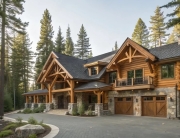
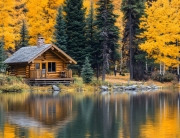
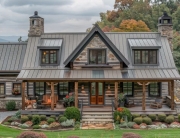
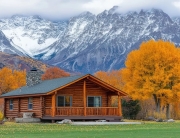
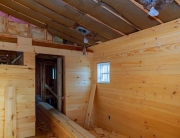
Recent Comments